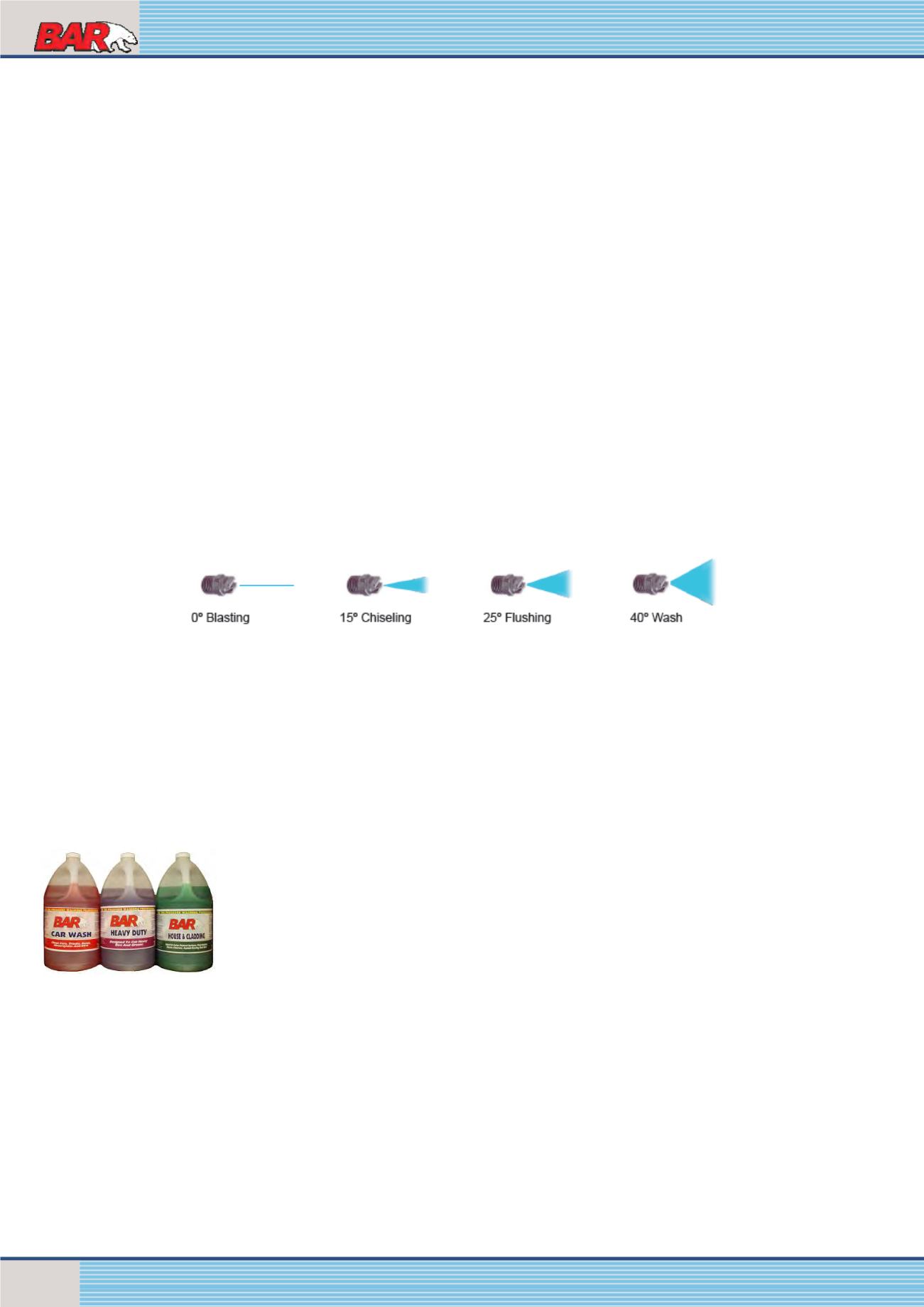
2014 August 1: Prices exclude Freight and GST. Subject to change without notice
458
Pressure Cleaners
Pumps: Belt vs. Direct, Wobble, Axial, Camshaft
The water pump is really the heart of the pressure cleaner system. The main difference between belt drive and direct drive pumps is that belt drive
pumps run at a lower RPM and are more insulated from engine or motor vibration, and therefore may extend the pump live. Direct drive pumps
are directly mounted to the engine or motor, which eliminates the extra cost of gearbox, pulleys, belts, etc. Expect to pay a price premium for belt
drives giving the same PSI, GPM, pump brand, and horsepower. However there is little actual difference in the pumps.
The basic pump models are the wobble, axial, and the camshaft. The wobble pump has lower performance and efficiency (70% efficient) due to
piston spring resistance on each stroke (pistons must push against the pressure in the pump PLUS the resistance from the springs). The axial
pump is similar to the wobble, but features a larger oil reservoir and larger bearings to allow the pump to run cooler to extend life. The axial pump
also has larger cylinders, which enable it to generate higher PSI and GPM ratings than a standard wobble. Although performance is improved, the
axial still is effected by piston spring resistance that translates in to lower performance and efficiency versus a camshaft pump.
The camshaft pump offers many benefits over the "wobble" and "axial-style" pumps. Due to the use of connecting rods and positive action pistons
(like a car engine), a camshaft pump is much more efficient (85% efficient) than an axial-style pump, which must overcome spring tension and
friction to generate pressure. Another benefit of this design is that a camshaft pump generates much less heat and therefore runs cooler than an
axial-style pump, and heat is the number one cause of failure in a high-pressure pump. For this reason, a camshaft pump can easily provide 1,000
hours or more of operation before needing any maintenance, whereas an wobble or axial-style pump typically has a life span of 200-600 hours,
after which the pump often can not be repaired economically. Also, when a camshaft pump does require maintenance, the easily accessible pump
head, replaceable cartridge-type valves, and ceramic piston sleeves makes repair quick and easy.
Tips on Proper Spraying Techniques
Operator error is the leading cause of user dissatisfaction when it comes to power tools, and pressure washers are no exception. There are three
ways to control the cleaning power of your pressure washer:
1) Adjust the throttle on the gas engine to control speed. Some units also may have a regulator knob on the pump that can adjust the pres-
sure (if so equipped).
2) Adjust the spray pattern at the nozzle. Choose the widest pattern possible for spraying when starting the job and adjust the pattern to a
narrower angle until you find a suitable pattern. Remember to temper power with coverage ability when spraying.
3) Finally, the easiest way to regulate the cleaning power of your pressure washer is distance from the surface you are cleaning. Begin sev-
eral feet from the surface and slowly move closer, adjusting the spray pattern as necessary. Hold the nozzle a uniform distance from the
surface to ensure that no part of surface is cleaner that another.
Nozzles and Tips
Many units feature nozzles with a variable spray pattern (0-40 degree angle), while others have individual quick connect tips with a pre-set spray
angle. The size of the nozzle influences both pressure and flow rate. The spray angle of the nozzle also plays an important role. The wider the
spray angle, the lower its ability to cut through dirt.
A wide pattern (40 degrees) will distribute the impact of water over a large area, resulting in excellent cleaning action with reduced surface dam-
age risk. The optimum angle for spraying water against a cleaning surface is 45 degrees.
A fan pattern (15-25 degrees) balances stripping power and washing. It is useful for moving dirt and is the best choice for cleaning large flat sur-
faces such as patios and driveways.
At 0 degrees, a narrow stream pattern delivers a high impact force resulting in maximum deep cleaning in concentrated area. The narrow stream
is best suited for concrete masonry or brick and can be used to remove paint or tough dirt.
Detergents
Detergents can dramatically reduce cleaning time and assist in the removal of tough stains, grease, bugs and dirt.
Apply them with a low-pressure spray and allowing them to soak into the surface to break down the dirt and
grime. Many detergents are customized for pressure washer use on specific cleaning tasks. Only use detergents
intended for pressure washers. Thicker detergents such as dish soap will clog the chemical injection system and
potentially damage your pressure washer. Be aware the EPA prohibits point source discharge of pollutants with-
out a permit. While this may not be an issue on the job site when using only water, if you are cleaning equipment
with detergents in shop or storage yard on a continuing basis, you should check on obtaining a permit and/or
installing a waste water recover system.
Importantly, if using detergents, flush the water pump with clean water after each use.


